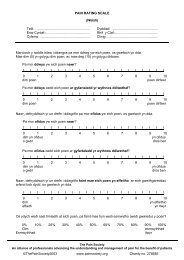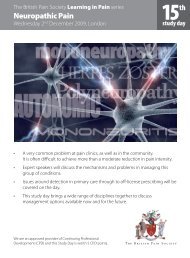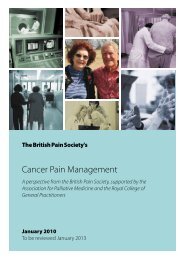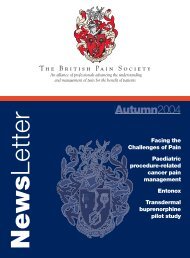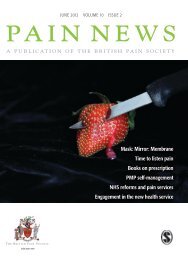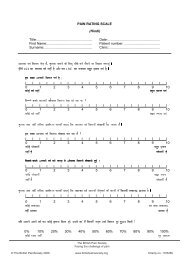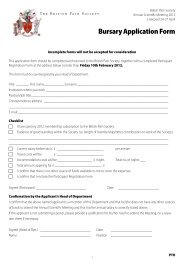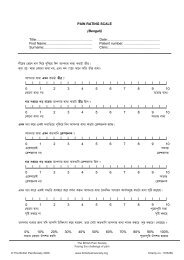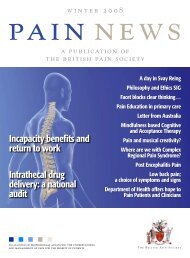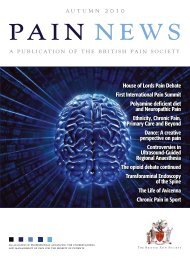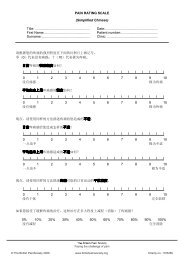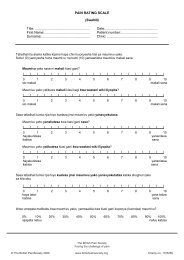Summer 2010 - The British Pain Society
Summer 2010 - The British Pain Society
Summer 2010 - The British Pain Society
Create successful ePaper yourself
Turn your PDF publications into a flip-book with our unique Google optimized e-Paper software.
<strong>Pain</strong><br />
controlled<br />
Constipation<br />
restrained1<br />
T0045 Date of preparation of item: January <strong>2010</strong>.<br />
By harnessing the synergistic effect of 37.5 mg tramadol and 325 mg<br />
paracetamol, 1-4 Tramacet delivers the same level of analgesia as 30/300 mg<br />
co-codamol – with 46% less constipation. 1 When patients can’t tolerate<br />
co-codamol, consider Tramacet – and now there’s a new presentation,<br />
Tramacet effervescent tablets.<br />
TRAMACET 37.5 mg/325 mg, film-coated and effervescent tablets. Refer to<br />
the Summary of Product Characteristics (SPC) for full details on side effects,<br />
warnings, contra-indications and overdose before prescribing. Presentation:<br />
Each film-coated and effervescent tablet contains 37.5 mg tramadol hydrochloride<br />
and 325 mg paracetamol. Film-coated tablets are pale yellow. Effervescent tablets<br />
are orange flavoured round shaped flat with bevelled edges, off white to slightly<br />
rosy coloured with some coloured speckles. One effervescent tablet contains<br />
0.4 mg sunset yellow and 179.4 mg sodium. Indication: Symptomatic treatment<br />
of moderate to severe pain; in patients whose moderate to severe pain is<br />
considered to require a combination of tramadol and paracetamol. Dosage and<br />
method of administration: Oral use. Film-coated tablets must be swallowed<br />
whole (not be broken or chewed) with sufficient liquid. Effervescent tablets should<br />
be taken dissolved in a glass of drinking water. Adults, elderly and children over<br />
12 years: Initial dose of two tablets; additional doses (not less than 6 hours<br />
interval) up to 8 tablets (300 mg tramadol and 2600 mg paracetamol) per day.<br />
Treat no longer than necessary, otherwise monitor. Children below 12 years:<br />
Not recommended. Renal insufficiency: Not for use in patients with severe<br />
insufficiency (creatinine clearance < 10 ml/min). Increase dosing to 12-hourly<br />
intervals in moderate insufficiency (creatinine clearance between 10 and 30<br />
ml/min). Hepatic insufficiency: Not for use in severe impairment. Consider dosing<br />
in moderate impairment. Contra-indications: Hypersensitivity to ingredients,<br />
acute intoxication with alcohol, hypnotic medicinal products, centrally-acting<br />
analgesics, opioids or psychotropic medicinal products. Current treatment with<br />
monoamine oxidase inhibitors (MAOIs) or within 14 days of use. Severe hepatic<br />
impairment. Epilepsy not controlled by treatment. Special Warnings and<br />
precautions: Not recommended in cases of severe respiratory insufficiency,<br />
severe renal insufficiency, and severe hepatic impairment. Paracetamol<br />
overdosage may cause hepatic toxicity. Use with caution in patients susceptible<br />
to seizures or being treated with medication to lower seizure threshold, especially<br />
selective serotonin re-uptake inhibitors (SSRIs), tricyclic antidepressants (TCAs),<br />
antipsychotics, centrally acting analgesics or local anaesthesia, due to the risk of<br />
convulsions. Concomitant use of opioid agonists-antagonists is not recommended.<br />
Use with caution in patients who have cranial trauma, biliary tract disorders,<br />
in a state of shock, in an altered state of consciousness, with respiratory<br />
dysfunction, or with an increased intracranial pressure. Tramadol cannot suppress<br />
morphine withdrawal symptoms. Tramadol can cause withdrawal symptoms,<br />
dependence or abuse. Avoid using during light planes of anaesthesia. In addition<br />
for the effervescent tablets: Sunset yellow E110 may cause allergic reactions.<br />
Sodium content to be taken into consideration by patients on a controlled<br />
sodium diet. Interactions: Concomitant use is not recommended with alcohol,<br />
carbamazepine and other enzyme inducers, and opioid agonists-antagonists.<br />
Consider concomitant use with serotoninergic medicines such as SSRIs and<br />
triptans, due to risk of Serotonin Syndrome. Other opioid derivatives (including<br />
antitussive drugs, substitutive treatments), benzodiazepines and barbiturates<br />
may increase the risk of respiratory depression. Other central nervous system<br />
depressants (anxiolytics, hypnotics, sedative antidepressants, sedative<br />
antihistamines, neuroleptics, centrally-acting antihypertensive drugs, thalidomide,<br />
baclofen), can increase the risk of central depression and medicines such as<br />
bupropion, SSRIs, TCAs and neuroleptics can increase the risk of convulsions.<br />
Evaluate prothrombin time periodically if given with warfarin like compounds.<br />
Other drugs known to inhibit CYP3A4 (ketoconazole and erythromycin),<br />
might inhibit the metabolism of tramadol (N-demethylation) and the active<br />
O-demethylated metabolite. Concomitant use with metoclopramide or<br />
domperidone may increase the absorption of paracetamol and cholestyramine<br />
may reduce the absorption. In limited cases, use of ondansetron increased<br />
tramadol requirement in postoperative pain. May affect ability to drive or<br />
operate machinery; effects are enhanced by alcohol or other CNS depressants.<br />
Pregnancy and lactation: Do not use. Undesirable effects: Very common<br />
( ≥1/10): dizziness, somnolence, nausea. Common ( ≥1/100,




